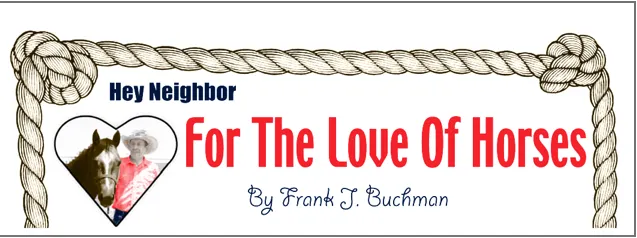“All horses must have a Negative Coggins Test in order to participate in any activities on the show grounds.”
That’s a common note on announcements for horse events or rodeos sponsored by many groups around the Midwest.
At first often annoyance to horse owners, requirement’s importance becomes apparent when a disease positive horse is identified.
Alarm sounded loudly a couple of years ago when several Western Kansas horses were confirmed positive for Equine Infectious Anemia (EIA).
The Kansas Department of Agriculture Division of Animal Health (KDA-DAH) received that confirmation from the National Veterinary Services Laboratory.
“EIA is an incurable, infectious disease caused by a virus afflicting equine species,” according to veterinarian Dr. Robert N. Oglesby.
The deadly disease, also called swamp fever, affects horses, donkeys and mules.
“There are typically a small number of EIA cases in the United States every year,” Oglesby said. “But, the disease is common in other parts of the world.
“EIA is controlled in the U.S. by regular testing before traveling across state lines and before exhibition,” Oglesby explained.
That analysis for EIA is generally referred to as a Coggins Test.
“The EIA virus destroys red blood cells and is spread through blood-to-blood transfusion, not close proximity or contact,” Oglesby informed.
Clinical signs of EIA include fever, anemia and edema. However, affected horses may not show symptoms.
“All infected horses, including those which are asymptomatic,” Oglesby said, “are carriers of the disease.
“Transmission of the virus can be from an infected equine to a ‘clean’ equine by biting flies,” he related.
Additionally, spread of the virus can be from using contaminated medical instruments, or through a blood transfusion.
“This disease does not affect humans,” KDA-DAH officials emphasized at the time of EIA confirmations in Kansas.
Research has shown that the EIA virus survives for a limited time on the mouth parts of the fly vectors.
“So the area of possible exposure is isolated to a relatively small radius around the affected premises,” KDA-DAH officials indicated.
Horses showing clinical signs are more likely to transmit the disease compared to those with an in-apparent infection.
“It is estimated after visiting an asymptomatic carrier, only one out of every six million flies is likely to become a vector,” Oglesby admitted.
“There is no vaccine or cure for EIA,” Oglesby emphasized. “Though most horses succumb rapidly to EIA a percentage of infected horses appear to recover.”
However, they still harbor the virus and during times of stress may become ill again.
“It is because of these healthy appearing carriers that we test horses,” Oglesby declared. “It insures that we do not put their mates at risk.”
The large horsefly is the main vector. “If they bite an infected horse and then bite a healthy horse, the disease gets transmitted,” Oglesby detailed. “The virus does not live for very long on the horsefly, maybe as little as 15 to 39 minutes. Still, the disease occurs anywhere horseflies live.”
With acute infection, the horse has fever, depression, and no appetite. “The acute horse may be difficult to diagnose because symptoms are very general. It will not be positive on the EIA test for a month-and-a-half,” Oglesby said.
Approximately one third of infected horses will die of the acute form within a month.
The chronically infected horse will have recurring acute bouts along with weight loss, blood deficiency, and swollen belly and legs.
“These horses will be positive on an EIA test but may linger for a year or more before they die,” Oglesby said.
“Most asymptomatic EIA infected horses will not show signs but are positive on a Coggins Test,” according to the veterinarian.
The Coggins Test checks for EIA antibodies in the horse’s blood. Blood samples must be sent to a state approved laboratory. Tests should be done on a yearly basis.
“Current testing programs have come a long way toward reducing this disease,” Oglesby credited. “Few people remember that prior to starting testing in the 1970s this disease killed thousands of horses annually.
“It was originally thought that the testing program would eradicate EIA,” Oglesby said. “But annually there are just enough asymptomatic carriers to perpetuate the problem.”
More than 1,300 Kansas horses were EIA tested in August 2017, according to the latest numbers posted by KDA-DAH.
Kansas had 15 positive horses in 11 years: three, 2007; two, 2008; four, 2016; and six, 2017.
Guidelines for protection include:
- Practice good fly control.
- Use a sterile needle and syringe for injections.
- Disinfect surgical equipment thoroughly between horses.
- Only administer commercially licensed blood products.
- Use a sterile needle each time puncturing multi-dose medication bottles.
- Require Negative Coggins Test when purchasing and for new horses on premises.
- Only participate in events that require evidence of a Negative Coggins Test
- Separate horses with fevers, low feed intake, lethargy and contact veterinarian.
CUTLINES
The large horsefly is the main vector in spread of Equine Infectious Anemia (EIA), also referred to as swamp fever in horses. If a horsefly bites an infected horse and then bites a healthy horse, the disease gets transmitted.
Blood must be taken from a horse for a Coggins Test to check for Equine Infectious Anemia (EIA). Samples are sent to a state approved laboratory for analysis.



